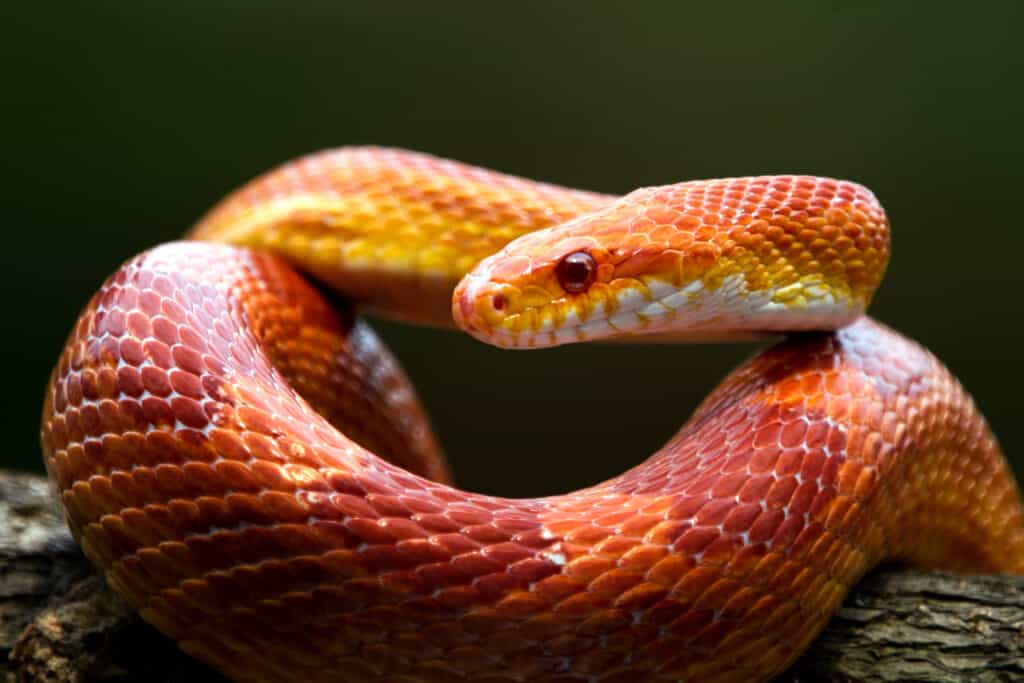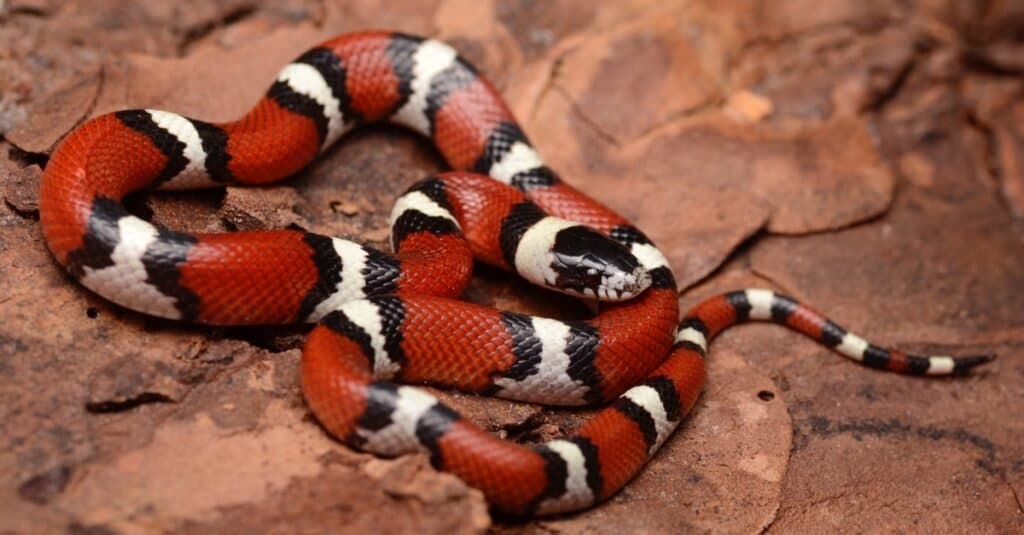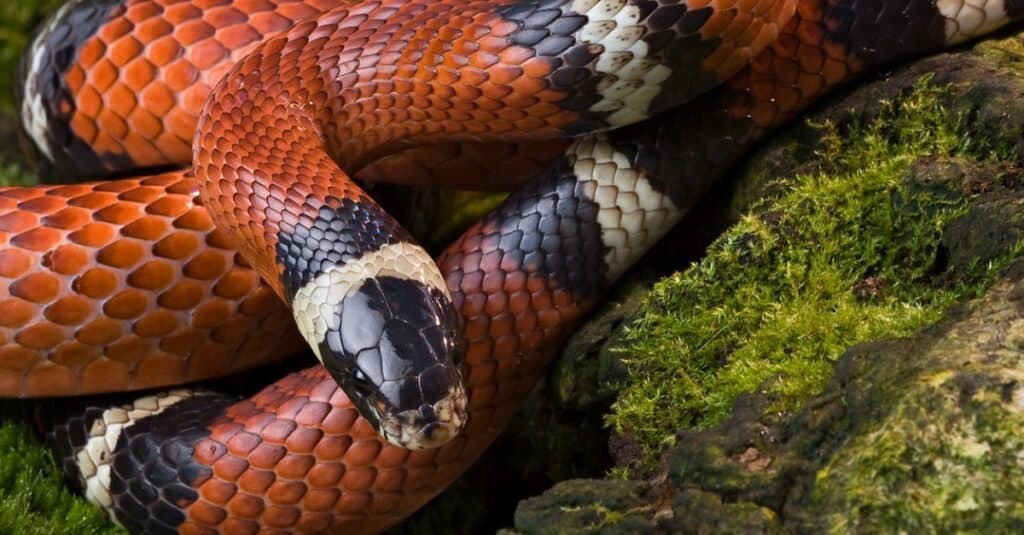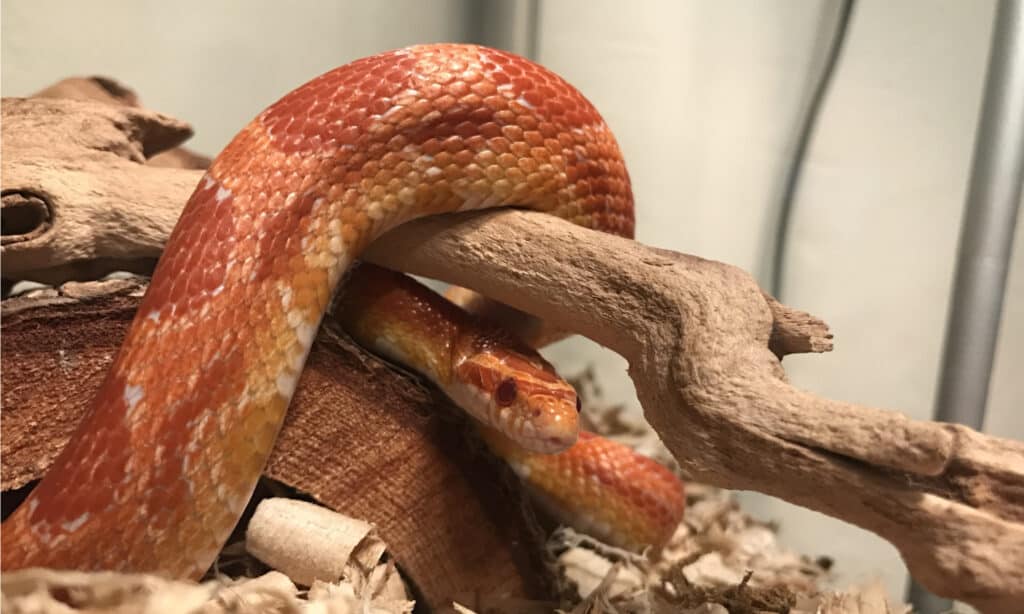Are you thinking about getting a pet snake? Choosing between a corn snake vs. milk snake can be tricky. Both species look beautiful and can live for over 20 years in captivity. To help you choose which snake suits your lifestyle, we’ve compiled this article comparing their similarities and differences. By considering each snake’s dietary needs, size, etc., making the right choice will be easier.
What are the top similarities between a corn snake and a milk snake? Follow along to find out.
Overview: Corn Snake

©Kurit afshen/Shutterstock.com
Corn snakes earn their name from the markings on their bellies. There are two rows of alternating white and black marks, which can resemble kernels of corn or Indian corn. You can also identify these snakes by their bright color. Corn snakes have orange to yellow colored bodies, with hints of brown. Down their backs, they have big red blotches outlined in black.
Sometimes called red rat snakes, these slender orange or yellow-brown snakes are initially from the eastern United States. However, you can find corn snakes throughout the southeastern United States, with many living in Florida.
People confuse corn snakes with copperheads, even though they couldn’t be more different. Corn snakes are a type of constrictor. That means they use their body to squeeze pray to death. Once the animal is subdued, the snake can swallow it whole!
How big do corn snakes get? These reptiles can grow anywhere from 24 to 72 inches long. Their exact size depends on the type of food available. Their favorite meals include rats, birds, bats, and mice.
Overview: Milk Snake

Milk snakes come in 25 different subspecies.
©TheTexasNaturalist/Shutterstock.com
Milk snakes are a species of king snakes. These solitary reptiles also have colorful patterning. You can identify these snakes by the big red bands separated by smaller yellow and black bands.
There are 25 different subspecies of milk snakes, each with its unique color patterning. For instance, the Sinaloan snake has a coloration that’s similar to coral snakes. However, these milk snakes aren’t venomous. Instead, the bright colors help keep predators away.
How big do milk snakes get? The Sinaloan milk snake can grow three and a half feet long. You can find these non-venomous reptiles throughout Mexico, with thriving populations in Chihuahua.
Differences Between a Corn Snake vs. Milk Snake

Milk snakes rarely grow over 3.5 feet.
©iStock.com/wScottLoy
Now that you know more about each snake, let’s dive into their top three differences. We can begin by looking at how big these snakes can grow.
1. Size
The first difference between a corn snake and vs. milk snake is their size. Both of these snakes are fairly small. However, corn snakes are slightly bigger than milk snakes. Corn snakes regularly reach lengths 5 feet long, while milk snakes rarely grow over 3.5 feet.
2. Attitude
Neither of these snakes has a reputation for being aggressive. However, pet owners feel corn snakes are more docile than milk snakes. Under stress, a corn snake is less likely to act out. If one of these snakes were to bite you, it wouldn’t be a big deal. Neither species is venomous, and they both have small teeth.
3. Feeding
Another difference between these snakes in captivity is how easy it is to feed them. Corn snakes don’t have a problem eating dead meat from tongs. But milk snakes can be trickier to convince. Instead, they do better with live rodents.
Similarities Between a Corn Snake vs. Milk Snake

Both milk snakes and corn snakes eat anything that moves in the wild, provided they can swallow it.
©iStock.com/mynewturtle
Moving on, let’s look at three similarities between these species. Corn and milk snakes have a lot in common, starting with their favorite foods.
1. Diet
In the wild, corn snakes and milk snakes are opportunistic hunters. They’ll eat anything that moves, as long as it’s the right size. This includes eggs, birds, smaller snakes, and frogs.
2. Coloration
Corn snakes and milk snakes look a lot like each other. Both reptiles have varying colorations, including red, yellow, and orange. They both also have a checkerboard-like pattern on their underbelly. To tell them apart, look at the brightness of their colors. You’ll notice corn snakes have a slightly brighter coloration.
3. Breeding
Did you know that some snakes lay eggs, and others give birth to live babies? Corn snakes and milk snakes are both egg layers. In the wild, they breed during brumation. Brumation is much like hibernation, but it doesn’t last as long. A typical brumation cycle will last several weeks.
Final Thoughts: Differences Between a Corn Snake vs. Milk Snake

Both corn snakes and milk snakes have long lifespans of over 20 years.
©Photohobbiest/Shutterstock.com
Now you know the top differences and similarities between corn and milk snakes. You’re on the right track if you’re considering owning one of these snakes as a pet. Take your time thinking about which snake best suits your lifestyle. Both species can live for over 20 years, so it’s a long-term commitment either way.
Consider what each snake needs in captivity to help guide your decision. For instance, are you willing to feed your snake live food?
Both snakes have carnivorous diets, which means they need plenty of meat. If you plan on owning a corn snake, you can feed them pellets or dead meat. But milk snakes are much pickier eaters. If you get a milk snake, get ready to buy mice.
The photo featured at the top of this post is © iStock.com/wScottLoy
Discover the "Monster" Snake 5X Bigger than an Anaconda
Every day A-Z Animals sends out some of the most incredible facts in the world from our free newsletter. Want to discover the 10 most beautiful snakes in the world, a "snake island" where you're never more than 3 feet from danger, or a "monster" snake 5X larger than an anaconda? Then sign up right now and you'll start receiving our daily newsletter absolutely free.
Thank you for reading! Have some feedback for us? Contact the AZ Animals editorial team.






